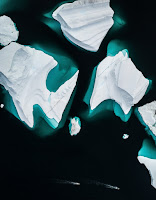The Arctic is a polar region located at the north most part of the world. It consists of Arctic ocean, Adjacent seas, a part of Alaska, Finland, Greenland, Iceland, northern Canada, Norway, Russia and Sweden. It contain seasonal sea ice in many places.
Climate change in Arctic circle
The extent of sea ice in Arctic is shrinking. The shrinking of ice may affect many habitats. It has affected polar bear and became the symbol of global warming.
The climate change in Arctic provides clear new shipping routes for trade and travel. Experts says the the shipping timing would reduce up to 40% if the Northwest and Northeast passages were ice free all years. It allows larger and heavier ships than the Panama Canal, which would increase trade and profit.
Arctic Treasure
The Arctic region has enormous deposits of oil and natural gas. Engineers and geographers estimate that oil and gas deposits in the Arctic makes up 13% of the world's undiscovered petroleum resource, and 30% of undiscovered natural gas resource.More than 400 onshore oil and gas fields have been discovered at the north of the Arctic circle. The major oil and gas area is in Russia
The Arctic is also rich in Minerals such as nickel and copper ore. Mineral resource also include gemstone and rare earth element(china currently represent 80% of rare earth element), which are used in batteries, magnets, and scanners. Many minerals are buried beneath the Arctic Ocean the minerals such as nickle, gold, molybdenum, silver, zinc, iron, tin, platinum, cobalt titanium, ceramic, mica and precious stones. There are also biggest known deposits of coal, Gypsum, and diamonds.
The Biological resources are one-fifth of the worlds fresh water are present in Arctic region and many largest rivers are found. Many types of fishes are found and supports valuable commercial fishing. Humans gains much from Arctic resource, and the region is very much important for global biodiversity.

Comments
Post a Comment